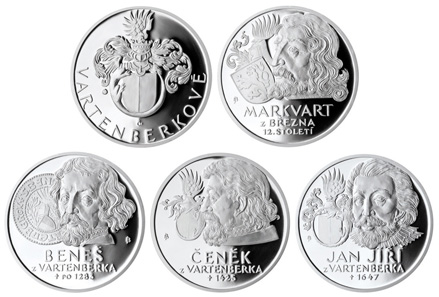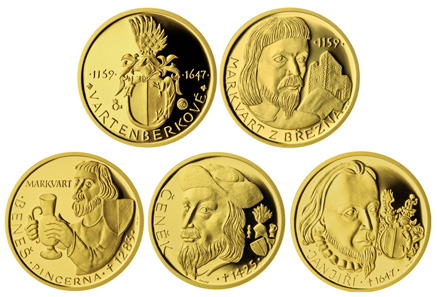August 30, 2012 – The Czech Mint has issued a set of four medals in gold and silver. Each medal is dedicated to a famous member of the Bohemian house of Wartenberg that flourished in the 14th and 15th centuries.
The silver medals were designed by Jaroslav Bejvl and are struck in proof quality and .999 silver. They have a diametre of 34 mm weighing 16.00 g each. Mintage: 800 pieces.
On the obverse the four medals show the Wartenberg coat of arms and running along the border the house’s name is inscribed in Czech: Vartenberkové. The distinguished representatives of the family are reproduced on the reverse in an idealised portrait in profile and three-quarter, besides is the contemporary form of the family’s coat of arms. In the exergue are indicated the name and the year of death in Czech: Markvart z Brezna 12. Století; Benes z Vartenberka + po 1283; Cenek z Vartenberka + 1425; Jan Jiri z Vartenberka + 1647.
The first ancestor of the Wartenbergs known by name – he figures on the first of the four medals – was mentioned in a document in 1159. This Markvart z Brezna (= of Brezna), as he named himself after the fief of Brezno, wielded the function of chamberlain in Bohemia.
In the course of the 13th century the house split into numerous branches. Probably it was Benes, d. 1283, who built Wartenberg castle being the first of the family to call himself after this new residence location. As Burgrave of Prague, cup-bearer, and chamberlain he had seized a key role in the Kingdom of Bohemia. The second medal hence is dedicated to him.
Cenek the Younger was a colourful figure. From 1408 until 1414, like many of his relatives, he was cup-bearer at the court of Bohemia. But when the reformatory movement of the Hussites concussed Bohemia he joined the rebels. However, the pillages and senseless destruction of monasteries and castles pushed him back to the Catholicism and thus, in 1420, he aligned with Emperor Sigismund. In 1423 Cenek was resoundingly defeated by the Hussites and died in the following year.
The gold medals have a diametre of 16.00 mm weighing 3.11 g and are designed by Majka Wichnerová. They are struck in .9999 gold and limited to only 500 pieces.
Another branch of the Wartenbergs took the name after the locality Decin. The men of this family branch filled the hereditable office of major cup-bearer at the royal court in Prague and they regularly held leading positions in the service of the king. When the Thirty Years’ War captured Bohemia too, Jan Jiri of Wartenberg aligned faithfully with his King Frederick I. Frederick, originally Count Palatine and Elector, later nicknamed Winter King, had laid claim to the Bohemian kingdom in order to strengthen the position of Protestantism in Europe
Anyway, doing so in the religious turmoil he took position against his own emperor and the Catholic League. These defeated him completely in the Battle of White Mountain in 1620 after a short one-year reign. The property of Jan Jiri of Wartenberg was confiscated by the victors and therefore, like nearly the whole Bohemian noblemen, he flew into the German exile to Saxony, where he died in 1647. With him the house of the Wartenbergs ceased to exist, a house of noblemen that had participated in shaping Bohemia’s history, and thus the history of the Holy Roman Empire, too.
The medals not only show felicitous portraits of the most prominent family members. One is able to understand the changes of the Wartenberg coat of arms as well. The original motive was a pacing lion. Then, ca. in 1300, a modification occurred. The coat of arms was simplified to a gold-black split shield. The last two medals exhibit the final appearance of the emblem featuring golden hearts as crest, the shield is entwined by a dragon alluding to the Hungarian Order of the Dragon. According to the legend this dragon was inserted into the emblem by Cenek.
More information on these medals are available on the website of the Czech Mint.





